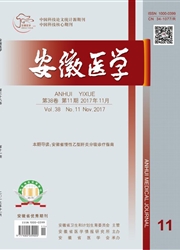

 中文摘要:
中文摘要:
目的了解各种临床标本中肺炎克雷伯菌的临床分布特点和一般性耐药情况。方法收集2011年9月安徽省32家医院报送的肺炎克雷伯杆菌,药敏试验采用琼脂稀释法,结果依据CLSI2010年推荐的标准进行判读。结果肺炎克雷伯菌主要来自痰标本,占76.05%;主要分布于ICU和呼吸内科,明显多于其他病房。药敏结果显示,肺炎克雷伯菌对2、3代头孢菌素表现出较高的耐药性,耐药率在28.2%。68.5%;对4代头孢菌素头孢吡肟比较敏感,耐药率为28.2%;对喹诺酮类的敏感率在70%左右;氨基糖苷类中的阿米卡星耐药率较低,为19.7%,而庆大霉素为70.6%;加酶抑制剂的抗菌药物比不加酶抑制剂的耐药率低很多;拉氧头孢、美罗培南和亚胺培南对该菌的敏感性最高。结论肺炎克雷伯菌临床分离株数多,耐药率较高,应加强临床使用抗菌药物的管理,预防和减少多重耐药菌株的产生。
 英文摘要:
英文摘要:
Objective To analyze the clinical distribution and antimicrobial resistance of Klebsiella pneumonia in order to provide the scientific evidence for clinical diagnosis and treatment. Methods The antimicrobial susceptibility test to 238 strains of Klebsiella pneumonia was performed by agar dilution method. The results were judged according to the criteria recommended by Clinical and Laboratory Standards Institute (CLSI) 2010. Results Most Klebsiella pneumonia came from sputum sample, which accounted for 76.05%. The bacteria was fre- quently distributed in ICU and Department of Respriratory. The results of antimicrobial susceptibility test showed that Klebsiella pneumonia was highly resistant to the 2nd and 3rd generation cephalosporins (28.2%-68.5%), but sensitive to levofloxacin, gatifloxacin, and the 4th generation cephalosporins. To aminoglycoside, the resistance rate (19.7%) to amikacin was low, whereas that was 70.6% for gentamicin. Carbapenems were the most active antimicrobial agents against Klebsiella pneumonia. Conclusion Klebsiella pneumonia is resistant to many kinds of antimicro- bial agents. The surveillance of antimicrobial resistance in Klebsiella pneumonia should be strengthened for purpose of preventing the transmis- sion of multidrug resistant strains.
 同期刊论文项目
同期刊论文项目
 同项目期刊论文
同项目期刊论文
 Prevalence of plasmid-mediated quinolone resistance determinants in association withb-lactamases, 16
Prevalence of plasmid-mediated quinolone resistance determinants in association withb-lactamases, 16 Stenotrophomonas maltophilia resistance to trimethoprim/ sulfamethoxazole mediated by acquisition of
Stenotrophomonas maltophilia resistance to trimethoprim/ sulfamethoxazole mediated by acquisition of Detection of the plasmid-mediated quinolone resistance determinants and the emergence of multidrug r
Detection of the plasmid-mediated quinolone resistance determinants and the emergence of multidrug r Surveillance of Antimicrobial Susceptibility Patterns among Shigella 5 Species Isolated in China dur
Surveillance of Antimicrobial Susceptibility Patterns among Shigella 5 Species Isolated in China dur 期刊信息
期刊信息
